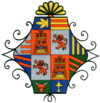Cabeza la Vaca facts for kids
Quick facts for kids
Cabeza la Vaca, Spain
|
||
|---|---|---|
|
||
| Country | Spain | |
| Autonomous community | Extremadura | |
| Province | Badajoz | |
| Municipality | Cabeza la Vaca | |
| Area | ||
| • Total | 64 km2 (25 sq mi) | |
| Elevation | 759 m (2,490 ft) | |
| Population
(2006)
|
||
| • Total | 1,620 | |
| • Density | 25.3/km2 (66/sq mi) | |
| Time zone | UTC+1 (CET) | |
| • Summer (DST) | UTC+2 (CEST) | |
Cabeza la Vaca is a small town in Spain. It is located in the province of Badajoz, which is part of the Extremadura region. The town's economy mainly relies on farming. Around Cabeza la Vaca, you can see many evergreen oak trees, olive trees, pine trees, and thick bushes.
Contents
What People Do in Cabeza la Vaca
The main way people make a living here is through farming. They raise animals like pigs, goats, and sheep. From these animals, they produce tasty foods.
Local Products
- Pork and pork products like red sausage and black pudding
- Cheeses
- Preserved vegetables
- Chestnuts
- Acorns
- Cork (from cork oak trees)
A Look Back in Time
Cabeza la Vaca has a very long history. People have lived in this area for thousands of years!
Ancient Times
Long ago, during the Iron Age, Celtic people lived in this part of Extremadura. Later, around 200 BC, the Roman Empire took control. The Romans built roads, like the famous Ruta de Plata (Silver Way), which was close to Cabeza la Vaca. This road connected the north and south of Spain. Farmers have even found old Roman coins when plowing their fields! The Romans stayed until the 5th century.
After the Romans, the Visigoths ruled. This period was important for the area. You can still see old Visigothic pieces reused in fountains and columns in the village.
Medieval Period
Around 711 AD, Muslim armies conquered Spain. This area became less populated for a while. Later, in the 13th century, Christian kingdoms began to take back land. The Kingdom of León and the Order of Santiago helped settle this area again. Around 1230, new settlers came, and the town was named "Cabeza de la Vaca de León." This marked the start of the town's modern history.
For a time, the language of León was spoken, but by the 14th century, Castilian Spanish became more common. The area faced challenges like wars and diseases. But by the 15th century, Cabeza la Vaca became a strong and stable town.
Connections to the New World
From the late 1400s, Cabeza la Vaca had ties to the Conquest of America. One important person from the town was Diego María de la Tordoya. He was born around 1460-1470 and traveled with Christopher Columbus on his first trip to the New World. Sadly, he died there. Later, in the 17th century, some people from Cabeza la Vaca moved to places like New Spain (modern-day Mexico) and Peru.
Changes Over the Centuries
The 17th century was a tough time for the economy. There were also conflicts with Portugal. But the 18th century brought growth. More land around Cabeza la Vaca was used for farming and raising animals. This helped shape the town's economy as we know it today.
In the 19th century, land ownership changed, and many farms became private. This meant fewer jobs for farm workers. Many people moved to cities to find work.
The 20th Century and Today
In 1905, Cabeza la Vaca had over 5,000 people. But then the population started to shrink. From the 1920s to the 1970s, many people left the town to find jobs in bigger cities like Badajoz, Seville, Madrid, Barcelona, and Valencia. Money sent home by these emigrants helped the town.
The Spanish Civil War also affected the town. It was a difficult time for everyone. After the war, life slowly improved. In the 1950s, electricity came to the village. By the 1980s, people had running water in their homes, instead of having to go to public fountains. Since the mid-1980s, Cabeza la Vaca has changed from a farming community to one that offers more services.
Things to See
Cabeza la Vaca is known for its beautiful natural surroundings and its old buildings.
Historic Sights
- The Cross of the Rollo: This cross is from the 16th century.
- The Fontanilla: This fountain has an early Gothic Christ statue from 1339.
- The Church: The main church dates back to the 14th century, and its bell tower was added in the 18th century.
- The Bullring: This building, used for bullfights, is from the 19th century.
- The Clock Tower: Also built in the 19th century.
See also
 In Spanish: Cabeza la Vaca para niños
In Spanish: Cabeza la Vaca para niños



